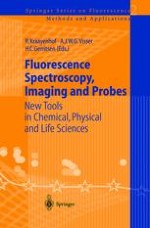2002 | OriginalPaper | Chapter
Fluorescence Nanometrology in Sol-Gels
Authors : D. J. S. Birch, C. D. Geddes, J. Karolin, R. Leishman, O. J. Rolinski
Published in: Fluorescence Spectroscopy, Imaging and Probes
Publisher: Springer Berlin Heidelberg
Included in: Professional Book Archive
Activate our intelligent search to find suitable subject content or patents.
Select sections of text to find matching patents with Artificial Intelligence. powered by
Select sections of text to find additional relevant content using AI-assisted search. powered by
We describe recent fluorescence studies of the formation dynamics and structure of sol-gel glasses from nanometre particles composed of silica clusters in sols to nanometre pores in silica gels. The “kinetic life-history” of silica produced under both acidic and alkaline conditions from sodium silicate in a hydrogel and from an alkoxide in an alcogel is now starting to be revealed by fluorescence techniques and the influence of key parameters such as pH and silica concentration quantified at the molecular level. Through careful choice of fluoro-probe, anisotropy decay has been shown to provide particle size as well as viscosity information and offer advantages over traditional techniques for silica particle sizing based on small angle neutron, X-ray or light scattering. Fluorescence resonance energy transfer (FRET) can now be used to determine the donor-acceptor spatial distribution function without making any a-priori assumptions as to its form. This in turn promises to make FRET a better means of monitoring pore morphology in the wet gel during drying and ageing, offering distinct advantages over dry gel techniques such as mercury porosimetry and nitrogen adsorption. The insight into sol-gel processes provided by these new interpretations of fluorescence decay data promises to have implications for both our fundamental understanding and the production of sol-gel systems.
